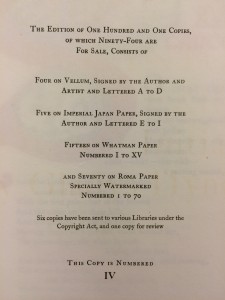Pound, Paper, Pomp
 [Posted by Dan George for ENG 812 Modern Poetry, Professor Rosen]
[Posted by Dan George for ENG 812 Modern Poetry, Professor Rosen]
Magisterial and imperious, I found the first edition of Ezra Pound’s Cantos 17-27 at the Watkinson. The ten cantos and their accompanying initials illustrated by Gladys Hynes span over about thirty pages, though the grandeur of the poem smolders with hugely outsized ambition.
In a volume over a foot tall, beneath a cover that divulges the bare minimum in gilded letters, Ezra Pound’s poetry lives. The presentation of the book is stylized like an unearthed medieval illuminated text. The initials span more than half the page of most of the cantos they precede and present the content of the canto in a succinct tableau.
It strikes me that the cantos contained in this volume, as well as the preceding cantos and a few to follow, did not enter trade publishing editions for years. The first cantos were printed in 1925, this installment came in 1928, the first trade edition went into print in 1933. During those years, Ezra Pound’s work was only available in these exclusive limited editions. The fissure of time (and, frankly, of the artistic quality in the printings) between these luxurious first editions and the trade editions suggests to me that this is how Pound primarily imagined a reader’s encounter with The Cantos. There is much to read into this gesture of exclusivity and extravagance.
 Only 94 copies of this book were printed on to four types of extremely fine quality paper. The first, most valuable set of four are signed by the author and artist, printed on fine calf vellum. The next set of five are signed by Pound and printed on Imperial Japan Paper. A set of fifteen on Whatman Paper, of which the edition in the Watkinson Library is one. The majority of the printing, seventy in total, are printed on Roma Paper.
Only 94 copies of this book were printed on to four types of extremely fine quality paper. The first, most valuable set of four are signed by the author and artist, printed on fine calf vellum. The next set of five are signed by Pound and printed on Imperial Japan Paper. A set of fifteen on Whatman Paper, of which the edition in the Watkinson Library is one. The majority of the printing, seventy in total, are printed on Roma Paper.
The selection of these four types of paper seems to be significant — they do more than make this book a valuable curio. Vellum represents the very dawn of print culture and is predated only by stone carved print and papyrus. Imperial Japan Paper is culled from a tradition of printed word that developed discretely from the Western European developments. This paper is a nod to Basho, and Confucius, and the pictogrammatic language that he appropriates for the Cantos. The Roma Paper is an archival quality of paper produced in Italy bearing a distinctive Romulus and Remus watermark. Pound’s fascination with eras of Italian Empire, and his eventual fanatical fascism, are gestured towards with this paper.
Whatman Paper came into being in the second half of the 18th century. Whatman developed a process of making laid paper that became the recognizable sheet of paper we are veritably awash in today. The improvement from a woven paper, the standard for European texts dating back to the medieval period, to a more industrially reproducible laid paper made a more widely profuse print culture possible.
One can glean much about the poem only considering little more than the paper of these original editions. In crafting these special editions, we get a glimpse at the promethean Pound. There is Pound the aesthete, the decadent with his uncompromising vision of how the poem must be. There is Pound the witting entrepreneur exasperating the demand for his poems with a cruelly cutting supply. There is Pound the literary snob that only wants to be cherished in elite coterie circles and would rather his poems stay off of every middle-class shelf. There is Pound the visionary that presents the poem and the presentation of the poem inextricably bound. There is Pound the maddening and maddened withholder.
 And then I think of the flimsy recycled pulp on which I first read these cantos, without the festive initials. I cannot help but feel that my first encounter of this poem was a pale simulacrum of the one I found in the Watkinson. The bombast with which The Cantos are presented here creates an occasion for a very different aesthetic experience with the poem. It is not a poem to be dipped into between train stops or waiting for a kettle on the boil. It is not a poem to be stuffed into a jacket pocket or tossed into a tote. One has to make time to be in the presence of it: maybe light a few candles, set some flowers in a vase, or rub fragrant oils on wrists. It is the occasion for a conjuring or a communing with the past.
And then I think of the flimsy recycled pulp on which I first read these cantos, without the festive initials. I cannot help but feel that my first encounter of this poem was a pale simulacrum of the one I found in the Watkinson. The bombast with which The Cantos are presented here creates an occasion for a very different aesthetic experience with the poem. It is not a poem to be dipped into between train stops or waiting for a kettle on the boil. It is not a poem to be stuffed into a jacket pocket or tossed into a tote. One has to make time to be in the presence of it: maybe light a few candles, set some flowers in a vase, or rub fragrant oils on wrists. It is the occasion for a conjuring or a communing with the past.